More Discoveries for “Otto Ege Manuscript 61”
May 23, 2017 in Manuscript Studies, Photographic Exhibition, Uncategorized
More Fragments are Revealed
from a Dismembered and Dispersed
32-line French Vulgate Pocket Bible
Made Probably in Southern France
circa 1325 C.E.
= “Otto Ege Manuscript 61”
Probably Southern France, circa 1325
Circa 186 × 126 mm
< written area circa 119 × 81 mm >
Double columns of 32 lines, with embellishments and running titles
[Posted on 23 May 2017, with updates]
Updating an earlier blogpost reporting A New Leaf from “Otto Ege Manuscript 61” in our series on Manuscript Studies, Mildred Budny (see Her Page) describes further progress in locating and identifying more parts from that little book. It should be said that, after the initial discovery and draft write-up, in the excitement of new discoveries, some long illnesses and a wrenching death in the family, with some gratuitous onslaughts from so-called family members, made it difficult to return on course. Back again.
These new discoveries go hand-in-hand with a rapid pace of strides further in continuing research on some other dismembered “Ege Manuscripts”, owned and dispersed by Otto F. Ege (1888–1951), as well as on some other manuscript fragments – which turn out to have unexpectedly interlocking patterns of transmission by 20th-century sellers. The advances are described in Updates for Some ‘Otto Ege Manuscripts’.
Read On, Dear Reader, Read On. To say that “The Plot Thickens” would take the words right out of our mouth.
Our blog on Manuscript Studies (with a convenient Contents List) first introduced a “New Leaf” from this dismembered Ege manuscript, after that isolated leaf had been recognized as such in the course of conservation, photography, and research for my Illustrated Handlist of a group of Medieval and Early Modern Manuscripts, Documents, and Printed Materials. In the Handlist, it holds Number 7. It looks like this, scale and color-guide included.
First the recto (at the right and below), then the verso. The leaf appears as Ege cast it out into the world, removed from its former fellowship in its original manuscript, where it had been nestled between the other leaves in their consecutive flow of text.
As identified and described in its debut blogpost, this leaf carries part of the Old Testament Book of Ezekiel, in its transition from Chapters 10 to 11. It has disconnected running titles on both sides of the leaf (EZE/CHI across the former openings between facing pages) and polychrome embellishment standing the full height of the page for the opening of the new chapter. The attractive style of compact layout, with decorative elements, provides an accomplished and distinctive standard which other leaves from the book share, and which encourages the identification of more leaves — even where their descriptions and/or images might circulate without identifying statements to this effect.
Note that the outer edge of the recto retains the remnants of Ege-style mounting tapes, which show that it had been matted at one time. Whereas some Ege leaves circulate “nude” (as with A New Leaf From ‘Otto Ege Manuscript 14’), , without mats or even without remnants of tapes for former mats, some others have been removed from their mats, with the tell-tale hinged tapes left to stand upon their edges, whether in full with their other halves, which had adhered to the mats, turned into “flaps” or in trimmed down at their hinged fold (as with More Leaves from ‘Otto Ege Manuscript 51’). Here, although the strips of tape have been pulled away from the leaf (already at a stage before I first saw it in about 2006), the remnants of their adhesive and cross-woven threads proclaim their former presence. Note also that, as frequently in Ege’s presentations, the original recto would have been attached to the mat, thereby placing the more decorative verso to the fore, visible through the front of the mat (albeit cropped by its window opening).
Ege’s Printed and Pencil Labels
Ege described his mounted specimen leaves from the manuscript thus in the printed label attached to the bottom front of the windowed mat:
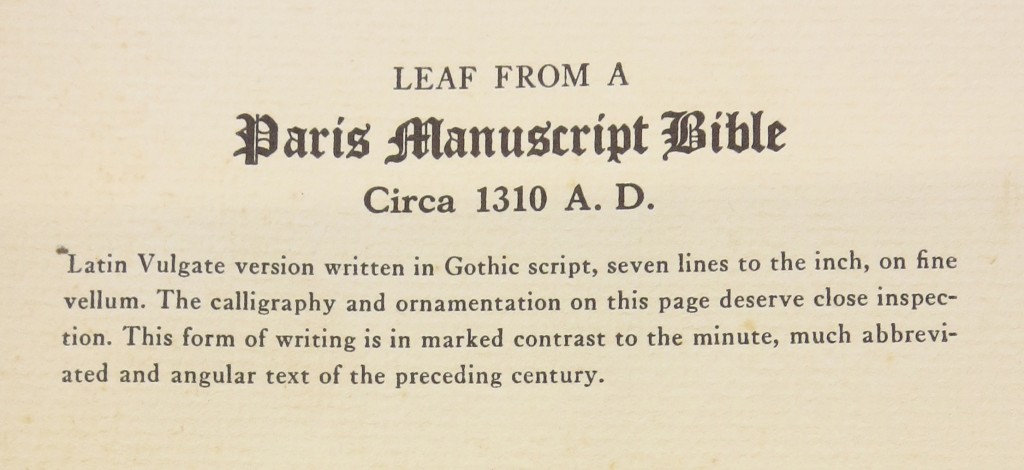
Otto Ege’s Caption for Any Specimen Leaf from the Manuscript. From the Set of Ege’s ‘Famous Bibles’ Portfolio in the University of Pennsylvania Libraries: Special Collections, Portfolio Bible 1 (Catalogue ID 6035076)
“Our” single leaf comprising Budny Handlist 7 (see the Illustrated Handlist) circulated on its own, and unmatted, without such an identifying label. It was possible to identify the text itself, all right, given the legibility of the script, replete with running title and chapter number.
But the first clue for me that the leaf belonged to one of Ege’s dismembered manuscripts — and not some other manuscript much like its small-format copy of the Vulgate Bible in double columns of 32 lines of the right dimensions with similar decoration and scribal features (say from the same center of production according to the same design template) — resided in the single-line Ege inscription in pencil at the lower margin of the recto, in Ege’s familiar script and in terms corresponding neatly to his printed label for the matted specimens.
The ‘Ege’ pencil inscription ‘1310 French Bible’ stands at the bottom of the recto. It would have been obscured, of course, when hidden behind the mat.
Scale Model
Putting things into perspective, you might like a view of the small scale of some Ege-and-Other manuscript fragments and scraps. In this “Group Portrait” of some Manuscript Groupies in the Illustrated Handlist, 2 isolated leaves respectively from “Otto Ege Manuscript 61” (Star of the Show in this Blogpost) and “Otto Ege Manuscript 8” (The Star here) stand at the left, first the one, then the other. By now, all the others also have their own Blogposts, as appropriate to any and all Prima Donnas. In this “Group Portrait”, the New Leaf from “Otto Ege Manuscript 61” stands at the top left, turning its back (or verso) toward us.
A Pocket Bible was designed for portability — indeed, that was one of its main attractions. However, the creators of this one might be surprised to see the extent of the portability to which this one has been subjected since the 1930s (see below), what with the fragmentation and scattered dispersal of many, most, or all of its leaves. A survey of the ways and means of this dispersal appears in the blogpost reporting A New Leaf from “Otto Ege Manuscript 61”. Some highlights of the story have a place in unravelling more of its threads, or following the way partly out of its Labyrinth, as shown here.
Ege Manuscript 61 = Gwara, Handlist, Number 61
We scholars have come to call it “Otto Ege Manuscript 61” because of its place in the recently established Handlist of Otto Ege’s Manuscripts, running from Numbers 1–325 (so far):
- “Handlist of Manuscripts and Fragments Collected or Sold by Otto F. Ege” assembled by Scott J. Gwara, Otto Ege’s Manuscripts: A Study of Ege’s Manuscript Collections, Portfolios, and Retail Trade, with a Comprehensive Handlist of Manuscripts Collected or Sold (2013), Appendix X (pages 113–201).
Cited here as: Gwara, Otto Ege’s Manuscripts, (2013), with relevant page(s).
Location, Location, Location
A starting point for identifying more leaves in current collections from “our” Pocket Vulgate Bible is Gwara’s partial list for each of the 2 “editions” of the Portfolio in which Ege circulated many of its leaves as single specimens. They appear in Gwara’s Appendix I and II (pages 95–96 and 97–99). Other fragments have surfaced in other locations — whether they have reached collections after the lists took shape for publication, appeared in transit between collections (for example in sales catalogues), or lay hidden from view in private collections or in institutional collections which had not yet catalogued them in recognizable ways.
University of Pennsylvania, Special Collections, Portfolio Bible 1
For example, a leaf and its Portfolio not in Gwara’s list resides at present in the Special Collections at the University of Pennsylvania (Catalogue ID 6035076). I learned about it from Dot Porter’s weekly postings of materials from that collection, when she exhibited online, tantalizingly one by one, the manuscript specimens in its copy of Ege’s Portfolio. An update to my first blogpost about Otto Ege Manuscript 61 reported and illustrated this survivor. Only much later did I have the chance to inspect the leaf itself, with some surprises. Partly the surprises have to do with other parts of this specific Portfolio and its appurtenances, which Dot’s postings of some individual manuscript leaves would not have had cause to consider.
There, the leaf from the pocket Vulgate Bible manuscript remains within Ege’s windowed folder-like mount, and it retains Ege’s printed label for the specimen Leaf from the dismembered Bible manuscript. Like our Handlist Leaf (shown above), its text belongs to the Book of Ezekiel. It, too, as matted, turns its original verso to the front and hides its recto, attached by the standard Ege mounting tapes, set in a pair more-or-less evenly distributed down the side.
First the verso, with its transition from one chapter to the next — replete with inset chapter numeral (XXXVI), inset 2-line initial F (for Facta), horizontal J-bar border ascending the full height of the column, and delicate pen-line flourishes. Contrasting with the brown ink of the text, these elements employ alternating red and blue pigment, with the flourishes in purple.
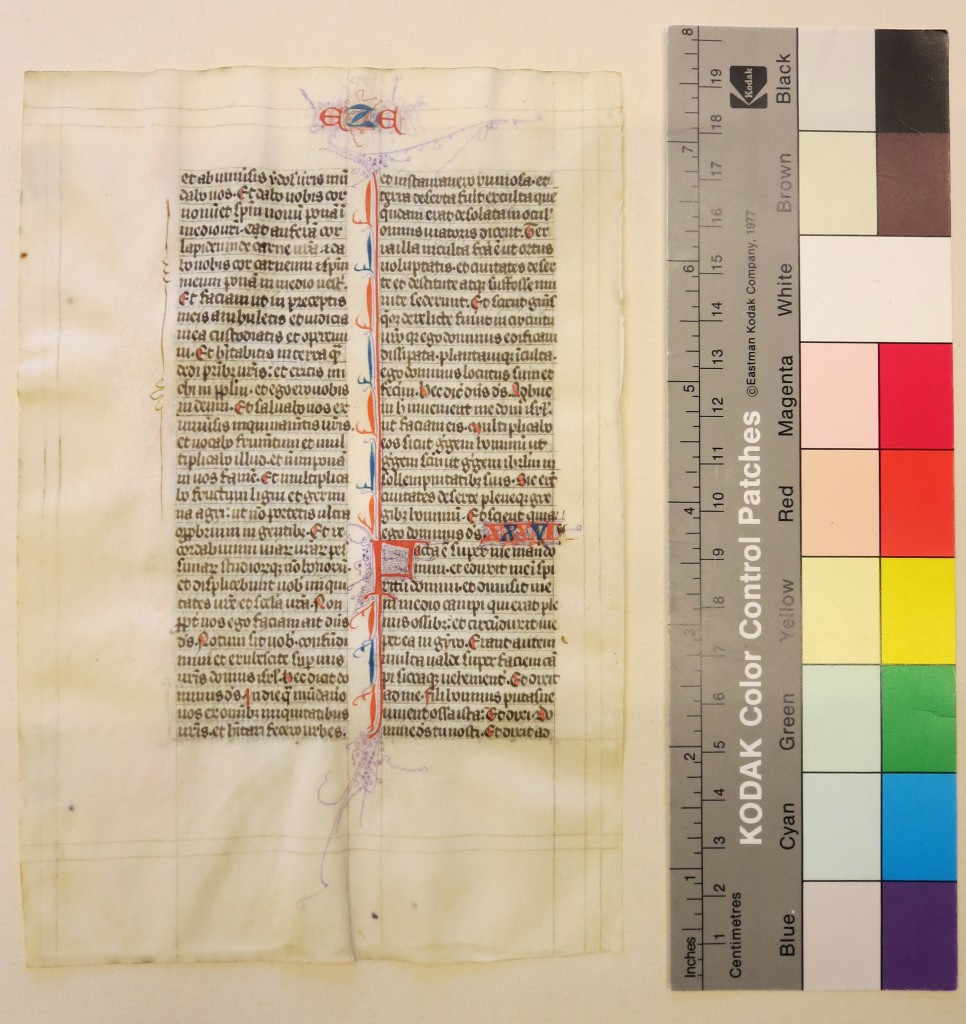
Original Verso of Leaf 2 in the Set of Ege’s ‘Famous Bibles’ Portfolio in the University of Pennsylvania Libraries: Special Collections, Portfolio Bible 1 (Catalogue ID 6035076). Photograph by Mildred Budny.
The plainer recto confines its colored embellishment to the running title, its purple pen-flourishes, and the red washes for the initials of verses. At the right-hand side of the text-block there appear the ghostly offsets in red pigment of some “unattached” pen-flourishes which extend far into the upper and lower margins.
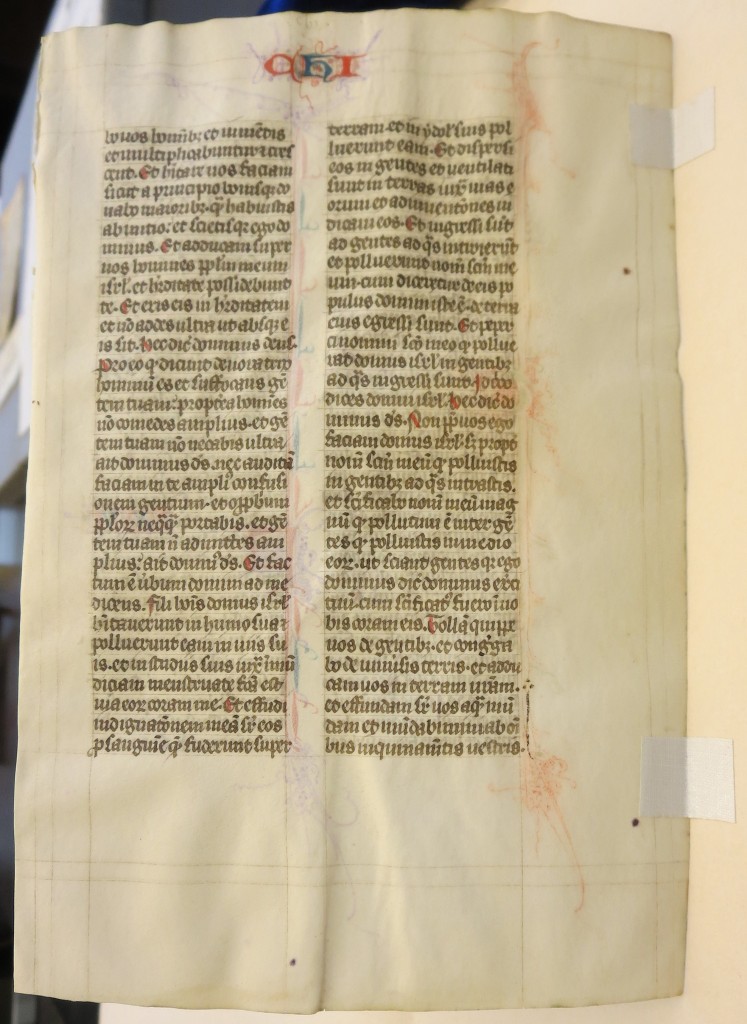
Original Recto of Leaf 2 in the Set of Ege’s ‘Famous Bibles’ Portfolio in the University of Pennsylvania Libraries: Special Collections, Portfolio Bible 1 (Catalogue ID 6035076). Photograph by Mildred Budny.
Unconnected with the text on the page itself, the offsets preserve instead part of the decoration on the facing page, now lost, or lost to sight. They continue the alternation in coloring between red and purple for the pen-flourishing from one page or column to another, just as the initials for the Chapters alternate between red and blue.
Reversing the photographic image (as here at the left) gives a closer indication of the formation of red pen-flourishing for the initial of the previous chapter as it stood — still stands if extant? — on its page. That initial would have formed T for Tu at the opening of Chapter 36. The sideways-extension opposite lines 13–16 establishes the location of the inset initial, which may, as usual, have stood 2 lines high.
Thus, already before that preceding leaf surfaces into view, or even if it has become lost altogether, we may glimpse some traces of its aspect. By such means, for example, we might be able to recognize it precisely when/if it turns up.
Real Estate
The University of Pennsylvania specimen forms part of Otto Ege’s Portfolio of “Original Leaves from Famous Bibles” in “Nine Centuries, 1121–1935 A.D.” My earlier blogposts on Otto Ege Manuscript 61 and some other Ege manuscripts (MSS 8, 14, 41, and 61, and 51) describe the complexity and variations, or inconsistencies, of this Portfolio and some others which Ege designed.
Seen from the front, its cover — in the version at the University of Pennsylvania — shows the gilded title in 3 lines of Gothic font within a triple-banded rectangular border on an applied label, which adorns the buckram-covered clamshell box.
When first embarking on the quest to recover — virtually recover, anyway — the surviving remnants of Ege Manuscript 61 (as reported in my first blog about it ), the nature, appearance, and characteristics of the individual Albums or Portfolios which contained them held less interest. So I thought.
Now, however, deciphering more of the traces of Ege’s production methods for various dismembered manuscripts and the various issues of his “Leaf-Books” (the Portfolios containing specimen original leaves from books of many kinds), I come to understand that any or every feature can hold the key to unlocking their secrets. They include evidence for the unrecorded, unrecognized, or incompletely understood stages of that 20th-century part of the history of their manuscripts, when pressed into service of a wider and fragmented distribution mixing “educational” aspirations with commercial purposes.
Famous Bibles in Nine Centuries and Two Series
Two Portfolios assembled by Ege share the same title of Original Leaves from Famous Bibles, Nine Centuries 1121–1935 A.D. Issued in 2 series or versions (with some variations), they are listed variously as
- Series A and B, for example in an inset printed caption found in a set of the latter Series (reproduced in Gwara, Otto Ege’s Manuscripts, Figure 61) or
- Series I and II, by both John P. Chalmers, ‘Checklist of Leaf Books’, Number 68 , and Scott Gwara, Otto Ege’s Manuscripts, Appendix I (pages 95-96).
Both Series of the Famous Bibles Portfolios (insofar as I have seen) are unnumbered, unlike Ege’s Portfolios of Fifty Original Leaves (containing “Ege Manuscripts 1–50”) and the different editions of the Famous Books in Eight Centuries and in Nine Centuries (Regular and Deluxe Editions respectively). Perhaps this condition of unnumbered sets reflects an earlier stage in the evolution of Ege’s Leaf-Books as an industrial standard.
Like the Famous Books Portfolios (see my blogpost on More Leaves from Otto Ege Manuscript 51), the specimens assembled in the Famous Bibles Portfolios include only a few leaves from manuscripts (their number of manuscripts varies, be it noted), while the rest come from printed books — a few of early-modern date, and all the rest are modern. The selected Bible specimens from printed books comprise various sizes and degrees of rarity, popularity, and/or curiosity. The few manuscript specimens seem to be chucked into the selection from what may have laid to hand, with an “exotic” Near Eastern manuscript (an Old Armenian example with lively initials) as their Number 1, plus a couple of Western medieval Bible bits — or sometimes one or two more of them for good measure.
It bears repeating — I didn’t realize it until looking for and looking at the Portfolios of Famous Books and Famous Bibles themselves — that their numbers of manuscript specimens vary, to an extent little recognized so far. Within a given Bible Portfolio or its Series, they may appear as 3 Leaves, sometimes 4, or occasionally more (up to 6). Accordingly, the Leaf Number for their specimens from “Ege Manuscript 61” can comprise Number 3, 4, or 6. Maybe also Number 5, but I haven’t found that so far. Which means that the search for survivors from a specific Western manuscript sometimes deployed in the issue does not necessarily succeed by that Numbers Game alone.
A Bonus
As soon as I opened it, the copy of Ege’s Album of Famous Bibles at the University of Pennsylvania revealed a Bonus. Earlier, as you know, I had come to know of its little Exodus Leaf from “Ege Manuscript 61” from the online images posted by Dot Porter among her weekly revelations of manuscript materials in the collection. How could I have known that the Album also contains some unusual materials, which the Library Catalogue had not mentioned?
The Bonus takes the form of an Extra Set of Loose Clippings enclosed within a manila folder, beyond the sides of which extend some larger leaves. The set comprises Random Specimen Leaves, in manuscript and in print, in vellum or on paper, along with the onion-skin paper sheets or slips carrying their typed labels (in carbon copies), plus a dated Receipt for the Album itself. For many viewers, this particular Bonus might not have special meaning or interest. For me, it was special. A thrilling discovery, in fact. More about that later.

University of Pennsylvania Libraries, Special Collections, Portfolio Bible 1 (Catalogue ID 6035076), Album Opened. Photograph by Mildred Budny
But first, the Portfolio as Ege shaped it. Within the clamshell box, the stack of matted specimen leaves pertaining to the Album have a Contents List, printed in black and red, which gives a generic account of the features in Bibles, whether manuscripts or printed books, pertaining to the sweep of successive centuries. Their features are described, or lumped together, in one or more sentences under their numbered headings from “XI Century” to “XX Century”.
Significantly, the Contents List does not itemize the leaves themselves, unlike Ege’s more famous, or infamous, Portfolio of Fifty Original Leaves. (Described in the blogposts on Ege Manuscripts (MSS 8, 14, and 41.)
Thus it allows for whatever assembly of specimens might have laid to hand. And it provides no precise checklist for the contents. Ege and any assistants could, and did, put some leaf or other from some manuscript (or printed book) or other as a representative, or one of the representatives, from the designated centuries. That variable, indeed haphazard, approach can bring unwanted surprises when chasing the present locations of specimens from a particular manuscript chosen for inclusion in the Portfolio edition, but omitted in some versions of it. Examples of omissions are reported in my first blogpost on Otto Ege Manuscript 61.
Paper Trail
The Receipt from Dawson’s Book Shop, 627 S. Grand Ave., Los Angeles, California, dated 4/27/37, records the sale of the Portfolio which has found its way to the University of Pennsylvania, and which reached Philadelphia already then. Very good to see the evidence of the transaction, source, purchaser, and other factors.
The handwritten entries on the printed receipt form appear in blue, apparently in carbon-copy. This duplicate must have accompanied the shipment to the buyer, named as “Dr. E. Krasenhaas”, via “Box 4378, Chestnut Hill, Philadelphia, Penn.” The contents, the price, and the tax-exemption are succinctly reported:
1 Ege Set of Bible Leaves $50.00
Out of State — tax exempt
The same price appears in pencil at the top left of the Contents List for this very Album (seen above). Founded in 1905 by Ernest Dawson, the bookshop closed in 2010. Readers of this blog may remember Dawson’s Bookshop from an earlier post, and the Printed Booklet which accompanies it (downloadable for free), reporting fragments of another dismembered manuscript distributed in part by this bookshop: New Testament Leaves in Old Armenian.
The Presentation(s) in the Portfolios
To recap, the Famous Bible Portfolios appeared in these ways (at least), with some variations mostly unrecorded:
I. Series A [or I], with 37 leaves in 200 sets, issued in October 1936
Famous Bibles, I = Chalmers, Checklist, Number 68
Gwara, Appendix I, pages 95–96, lists the locations of 31 sets, including one set ‘now dispersed’.
II. Series B [or II], with 60 leaves in 100 sets, issued in October 1938
Famous Bibles, II = Chalmers, Checklist, Number 73
Gwara, Appendix II, pages 97–99, lists the locations of 51 known sets.
Finding Places, Finding Aids
Searching for extant leaves from the manuscript involves several resources, and a certain resourcefulness. Online library catalogues, online displays of library holdings, sales listings, blogs, and other means, including some printed reference works, offer guides, more and less reliable and more-or-less haphazard. Efforts to standardize catalogue descriptions for multiple collections can both help and hinder, depending upon the accuracy of the reports and the conflation of different specimens under a standard template.
WorldCat Hunter
Consider WorldCat: The World’s Largest Library Catalogue. The location of some instances of Ege’s Portfolios appear among its listings. By now, it has a standardized online list, or rather set of overlapping and entangled lists, for the Famous Bibles Portfolios. The lists consider them in several ways:
- Original leaves from famous Bibles : nine centuries 1121-1935 A.D. (OCLC 19087806)
“1 case ([60] leaves) ; 49 cm” - Original leaves from famous Bibles : nine centuries 1121-1935 A.D. : collected and assembled by Otto F. Ege. (OCLC 522913)
“1 case ([39] leaves) ; 52 cm” - Original leaves from famous bibles: nine centuries 1121–1935. Sixty leaves from famous and rare Bibles and Testaments, dating from the twelfth to the twentieth century, have been selected to illustrate important in content and format (OCLC 3060207)
“60 leaves of mounted plates ; 52 cm”
However, these lists are conflated and partly confused, partly because of that conflation. As a result, sorting out the accurate information from the garbled reports amounts to the challenge of separating the wheat from the chaff. To call it a challenge is to state the obvious. But to make progress with that challenge can be painstaking, laborious, frustrating, and incomplete.
All three WorldCat entries list the same 55 institutional owners (so far, by February 2017). Two entries (OCLC 19087806 and OCLS 522913) report almost verbatim — variants in the latter are shown here in [red] — that the set
Consists of 1 preliminary leaf and 60 [or 38] individually matted original leaves, with a printed explanatory caption mounted on the verso of each mat.
Title from preliminary leaf.
Includes 3 manuscript [or ms.] leaves on vellum: “Leaf from an Armenian manuscript Bible, 1121 A.D.,” “Leaf from a miniature manuscript Bible [Latin Vulgate] circa 1240 A.D.,” and “Leaf from a Paris manuscript Bible [Latin Vulgate] circa 1310 A.D.”
Both entries contain almost the same list of plates. Their printed specimens extend from the “First Jenson Bible, 1476”, to the “Rogers Oxford Lectern Bible, 1935”. However, they differently report their 3 manuscript specimens. The first (the 60-leaf edition) omits the Armenian leaf altogether:
Paris manuscript Bible, 1310 —
Cambridge Bible, 13th cent. —
Latin Vulgate Bible, 1230 –.
The second (the 38-leaf edition) claims the Armenian specimen, and swaps 2 different Western manuscripts, including the pocket Vulgate Bible of “1240”:
Armenian manuscript Bible, 1121 —
Miniature manuscript Bible, ca. 1240 —
Thirteenth century manuscript Bible, ca. 1280, Italy –.
The third WorldCat entry (OCLC 3060207), with 60 leaves, is more summarily described.
Each leaf is mounted and most are accompanied by descriptive letter press.
Accompanied by leaf containing introductory material.
In a brown cloth folding case.
No list of plates. No luck.
Lucky Dip
The homogenized and garbled lists, serving as a template to hang a new candidate for the group (or whichever of those groups, indiscriminately) obscures the facts that some sets do not contain a leaf from that “Paris Manuscript Bible circa 1310 A.D.” (= Ege Manuscript 61).
Nor do they mention numerous other multiple variations which would be significant, nay essential, for a scholar attempting to detect, locate, identify, and reconstruct the surviving parts of the individual dismembered manuscripts. Such information would also aid, and sustain, efforts to investigate the changing workshop practices which Ege manifestly employed in assembling and disseminating the Series — to judge by my examination already of only a few of the Portfolios themselves, or parts thereof.
There is more to see, that is obvious. Provided that “it” becomes available somehow for the viewing.
The WorldCat entries can provide a sort of starting point, but each and every entry might require scrutiny, because of the drive to standardization which rides roughshod over the differences inherent in manuscripts, and in fragmented manuscripts. A byproduct of the fragmentation of the subject(s) is that the different manuscript fragments often present themselves with or without identifying inscriptions or labels, they may have been removed from the Albums and/or their mounting mats (printed labels included), and the forms of identification may be imperfect, inaccurate, misinterpreted, replaced, revised, or rejected.
Checking the individual institutions’ own websites and catalogues not only takes much time. So far, it brings scant useful results, partly because some of the institutions do not record the items within their catalogues, partly because some adopt the standardized entry without noticing or noting that their copy exhibits variants from it, partly because the specialization of expertise may prevent or delay awareness of the significance of specific details (especially with such mixed-media Part-Works created, if that is the word for it, by the fragmented Leaf-Book Portfolios), and partly because they do not include digital representations of the items.
Learning how to read the entries, and to re-read them in the light of enhanced knowledge of the Portfolios, their variants, the Leaf in Question, Ege’s workshop practices, and the activities of some sellers or owners, brings more evidence to light than might have been expected. Sounds like Research as Usual to me, that is, based upon the firm need to check, and recheck, the sources, to see if possible which are true, which are false, and which mix up those categories, whereby their “truths” are that they are wrong, or partly wrong, and whence they derive or declare their information.
Cases with Bonuses
Another blogpost will report the serendipitious discovery, among the Extra Set of Clippings in the University of Pennsylvania’s Portfolio, of a fragment from a Known Manuscript (known, that is, by me, but not before now to scholars of Ege, except that I count as one of them) among some Extras in a set in Philadelphia.
Suffice it to say here that the merits of closely checking the individual institutional catalogues can yield extra discoveries of such kinds. My discovery at the University of Pennsylvania leads to an improved catalogue entry for that Porftolio, with its extras. Other such extras are already indicated, albeit in tantalizingly summary form, in some other collections which I have been able to explore through their listings in the WorldCat entries for either of Ege’s Bible Portfolios, sometimes augmented on their own websites.
For example, the entry for the Portfolio at the University of Virginia (here) includes these “Local Notes”, which tantalizingly demonstrate that this set includes Extras:
Housed with this are 12 additional manuscript leaves [listed within the entry proper, including a leaf labeled “Latin Vulgate, France, 1240”]; 11 appear to be from a set of window-mounted leaves, with red rules framing the windows. Each is identified in pencil at the bottom of the mount, and all have pencilled number 74 followed by a changing number, as in 74/16, 74/18. The 12th leaf is identified only as a medieval manuscript, circa 1440, and was sent as a Christmas Card in 1948 from Fanny and Philip Duschnes.
Sight unseen, I venture to suggest that these Extras stand with Ege-style mounts (of the red-lined variety), perhaps with pencil notes providing Ege’s bits of inventory-style information, in addition to the series of numbers. And some of the Extras may belong to known Ege Manuscripts.
Far and Wider
So, identifying the surviving bits of the Vulgate Pocket Bible of “circa 1310 A.D.” continues to post major challenges. Unless and until each and every institutional collection — not to mention all individual collections, which may have their own dynamics, resources, and reasons — renders readily accessible fuller and accurate descriptions of their holdings in the Portfolios, and/or digital images of them, it cannot be hoped that a full picture of the extant parts of the book will emerge. That parts from it continue to circulate around, or return to, sellers’ markets postpones or complicates the picture as well.
Sellers’ Delight
Some examples tantalizingly state the existence of one or more leaves which must correspond to a portion of Ege Manuscript 61 by virtue of the context of the “find-place” in the relevant Portfolio, the terms of its description (for example, “1310” Bible Leaf), or photographs.
- Swann Auction Galleries, Sale 229 (10 November 2010), Lot 25 comprising Portfolio Series II (an incomplete set), with the “1310” Bible Leaf listed as Number 3 (no image); also announced here (no image)
- Phillip J. Pirages, Catalogue 70. Medieval Manuscript Material: Including Single Leaves and Complete MSs (undated; probably 2016), lot 4 (page 4), “Six Vellum Manuscript Leaves from Various Pocket Bibles in Latin, Offered as a Group”, with a leaf recognizable in the accompanying photograph as one from Ege Manuscript 61; its recto appears at the right in the overlapping row as reproduced in the plate
To judge by its reduced photograph in the Catalogue, the recto of the Pirages Leaf carries part of the Matthew Gospel, chapters 6–7. Dunno what part of the text appears on the Swann Galleries leaf, current whereabouts unknown (to me).
Did we mention that the quest can be frustrating as well as complicated?
Hopeless? Maybe Not. Some things about the book can be known, or become better, more clearly know, and some conjectures about it can be rejected.
Specimen Leaf Number 3 or 4 or 6 or 1 or Nil
Within both Series of Ege’s Portfolios of Famous Bibles, leaves from the source manuscript appear as Number 4. Or so I used to think, as reported in my earlier blogpost on A New Leaf from “Otto Ege Manuscript 61”.
Experience now shows that in the different sets, if it appears — and it does not always do so — it can hold the place of Number 3, Number 4, or Number 6 (see below). Who knows, it might even appear in some as Number 5, only I haven’t noticed that yet.
Experience also shows that it can be rash, until all the evidence is known, to discern that Ege’s habits of labelling and mounting individual leaves, assembling them in albums (or not), and distributing the results conform with a specific pattern or set of patterns. Because new discoveries, which can include unexpected “find-places”, may reveal previously unsuspected patterns.
That is part of the price for the destruction, neglect, and dispersal of so much of the evidence and contextual evidence. That is a partial reward for perseverance (well, and serendipity) in the quest to discover more of the evidence, however hidden, undocumented, disregarded, and unnoticed. Useful when the relevant expertise meets the materials. My continuing study of Ege Manuscript 61, its fragments, and their distribution, is one such case, as this updated report demonstrates.
The Number Game or Gain
In Scott Gwara’s Handlist of Manuscripts Collected or Sold by Otto F. Ege (2013), the manuscript, with its traceable remnants, is Number 61 (Appendix X, pages 140–141).
The ‘find places’ of the dispersed leaves within these Portfolios establish that the dismemberment had already begun by the time of the preparation of the first Series, that is, at the latest, by 1936 (although cited as ‘1938’ in Gwara, Otto Ege’s Manuscripts, page 346). The dismemberment and dispersal of some Portfolios themselves (as here) might seem like fair play, or anyway turnaround.
The two declared series of 100 + 200 sets with 1 leaf apiece in the Portfolios account for 300 leaves, with many more to spare.
Some other detached single leaves or bifolia (the paired, conjoint leaves from the single, folded sheet of one animal’s skin) have surfaced as ‘Ege Rogue Leaves’ — that is, not issued in any of Ege’s Portfolios but only by other means — including the New Leaf. Some are listed as Gwara Handlist Numbers 61.1–7, belonging to various institutional collections in the United States. Now emerging in private ownership, newly identified as an Ege Lost and Foundling, the New Leaf deserves to be added to their company.
Parts of the Pocket Bible, Prices & Mats Included
Some of the dispersed leaves which circulated apart from the Portfolios carry the seller’s annotations and/or labels upon themselves or the mats accompanying them.
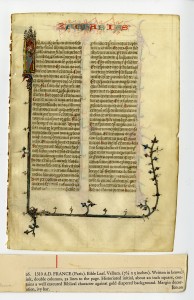
Recto of Leaf Opening the Book of Zachariah, plus Clipping from its Sale Catalogue. Courtesy of Flora Lamson Hewlett Library, Graduate Theological Union, Berkeley, CA. Reproduced by permission.
For example, the leaf at the Flora Lamson Hewlett Library of the Graduate Theological Union in Berkeley (shown here) is accompanied by part of the Ege-style mount with red-ruled lines, a note in pencil identifying the piece as having illumination (therefore more valuable), and the unevenly-trimmed clipping for Item 26 in a sale. It reads:
26. 1310 A.D. FRANCE (Paris). Bible Leaf. Vellum. (7 1/4 × 5 inches). Written in brown ink, double columns, 32 lies to the page. Historiated initial about an inch square, contains a well executed Biblical character against gold diapered background. Margin decoration, ivy bar. $20.00
As soon as I saw this clipping, I recognized its source. So glad that the images of the leaf generously supplied at higher resolution for publication in this blogpost were not cropped, showing more than the images on the library’s website (here)! The uncropped portions give a bonus! They tell, or, rather, they can tell (with the scholar’s expertise as interpreter), more about the steps in the transmission between Ege’s whole manuscript and the leaf’s present location.
Its clipped entry for Item 26 appears in the printed 1944 Catalogue of portfolios, manuscript pages, miniatures, and printed leaves from Ege’s Collection offered for sale through the Lima Public Library Staff Loan Fund. The 15-page catalogue is reproduced in Gwara, Otto Ege’s Manuscripts (2013), figures 41–48 (on pages 253–260). Item 26 stands partway down its page 7, reproduced in Gwara’s figure 43 (page 255).
The leaf itself is “exquisite”, as aptly described by the Special Collections Librarian, David J. Stiver, in responding generously (email communication) to my request for permission to reproduce the leaf in this blogpost. The recto opens the Book of Zachariah. Its running title spread expansively at the top for the name in full — rather than, as for sections of text which spread a single text (or Book) across both pages of a given opening, with the opening part of that name on the verso and the second part on the recto.
Do you see the faint ink note at the top (trimmed?) which, in an unsteady script, transcribes and deciphers the fancy forms of the title? That script may be difficult to date precisely, but it looks medieval, say 14th-century. In other words, it would have been called for some time after the fancy style of embellished script had gone out of fashion and out of practice — meaning out of the habits both of writing and reading it. So a transcription would both aid a viewer’s recognition and celebrate a subsequent reader’s struggles to decipher the text, letter by letter. Not to mention leaving a trace of presence upon the page.
The Recto:
The Verso:
The verso applies the treatment standard, for known leaves from the book, of enhancing and embellishing the opening of each Chapter within a Book of the Bible by an enlarged and inset initial (here 2-lines high) in red or blue pigment, extended pen-flourishing in a contrasting color (purple or red), and a vertical border at the the left-hand side of the column of text composed of a frieze-like pattern of interlocking L-shaped bars.
The Border and Historiated Initial: Meet the Prophet
The full-page J-shaped border ornament, consisting of bars with offshoots of foliate ornament, frames the text as it nestles against the left-hand column, runs across the lower margin, and rises alongside the right-hand column, to reach nearly half-way up its block. At the left, the top of this frame curves outward in the form of a winged dragon-like creature which faces left with opened jaws and supports on its back a narrow architectural niche.
That inhabited niche forms the structure of the opening letter I (for In) of Zachariah’s Biblical Book. Standing 7 lines high and ascending into the outer and upper margins, it slightly displaces the lines of text to form an inset area into which it presses, more closely than the decorative bar-shaped border below.
A pair of slender columns with stubby, asymmetrical bases and capitals supports a steeply pointed arch flanked by a pair of pinnacles. Both the pinnacles and the pediment carry an array of crockets. The roof of the structure includes a void trefoil in its spandrel.
Between the columns stands a full-length bearded figure. He adopts a swaying pose as he turns partway toward the right, holds his right hand in front of his waist, raises his left hand with outstretched fingers and thumb in a speaking gesture, and looks upward toward the opening words of his text. His long beard, shoulder-length curly hair, and pointed cap complete the picture of the Old Testament in his element.
Squared Or Not
While looking at this initial, we may observe that the description for Item 26 in the 1944 Sales Catalogue could not have been written from this specimen. It claims:
Historiated initial about an inch square, contains a well executed Biblical character against gold diapered background.
Nope, not really. As with some specimens from other Ege cases (see, for example, the report for A New Leaf From ‘Otto Ege Manuscript 41’), the caption does not conform to the specific case.
Not by any stretch of the imagination does the narrow 7-line-high image with Zacharias as Prophet–Author qualify as “square”, nor is there any “gold diapered background” in sight. “A well executed Biblical character” denotes a single figure rather than a scene. That much is clear. That phrasing could imply that, for the most part, or insofar as it was noticed, the numerous illuminated initials comprised single Author-Types, rather than a scene which their Author’s text related. Perhaps in time the prototype for the description may re-emerge into view.
Priced Accordingly
According to Otto Ege’s caption for the dual Portfolio series, the original manuscript comprised a ‘Paris Manuscript Bible, ca. 1310 A.D.’ Hence, obviously, the ‘Ege inscription’ in pencil at the bottom of the recto of the New Leaf: ‘1310 French Bible’.
According to the advertised prices (reported in Gwara, Otto Ege’s Manuscripts, page 348), single leaves from this very bible cost US $2.50 for a leaf, and $20.00 for one with a historiated initial, in the 1944 Lima Public Library sales catalogue, and their prices had risen respectively to $3.50 and $25.00 in a sales catalogue of circa 1952 (now at Samford University, Birmingham, Alabama). Unlike some other ‘Rogue Leaves’ from Ege Manuscripts (for example in the Budny Handlist, illustrated here from Ege Manuscript 14′), the ‘Ege inscription’ on the New Leaf does not cite its price.
Like the ‘Ege-matted’ Portfolio leaves and some other ‘Rogue Leaves’ from Ege Manuscripts, this leaf preserves the traces of its ‘Ege-style mount’ in the form of the characteristic gummed gauze tapes. When I first saw the leaf, this was its condition, with the tapes having already been removed (almost), along with their former mat (now lost). Hard to say when that removal, and the discarding of the mat, occurred. Perhaps even before the leaf reached its present owner, at a time unremembered and unrecorded.
The Books of the Bible
Some specimens of Ege Manuscript 61 can be viewed freely online. They include examples from Portfolio Series I, Portfolio Series II, and other forms of distribution, with or without Ege mats. Some without mats, like the ‘New Leaf’, retain the traces of the former mounting tapes characteristic of Ege’s treatment. All such signs can offer significant evidence for the patterns of distribution of the leaves, and can aid identification of leaves as parts of the former manuscript.
It is worth recording that some sets of the Portfolios, such as the Portfolio Series II at Kent State University, do not contain a leaf from this Bible. The beauty, perhaps, of Ege’s Contents Lists printed to accompany both Series enables various sets to issue forth with Bible manuscript specimens from one or another source manuscript, as if they were indeed interchangeable.
It is to be hoped that, in the future, the online catalogue reports for individual sets or leaves, as in WorldCat and elsewhere, would take care to indicate the specifics of their contents. This said with recognition that cataloguers and librarians may not always have at their disposal the time, funds, and/or worldwide expertise to recognize and indicate all significant aspects which scholars now and in the future may wish to know in pursuing research, even when the details, correct or otherwise, may guide the choices for that course. About this subject, and its occasional mis-directions based upon the faulty reports of manuscript materials, even by experts, I have had cause to report some experience and necessary revisions in a recent Congress Paper for the Research Group on Manuscript Evidence. See its Abstract: Budny (2016 Congress).
Toward a Virtual Reconstruction of the Manuscript
My earlier blogpost listed some leaves whose contents had been identified; some of those identifications were mine, or my improvements/corrections for existing identifications. That list arranged the leaves in order partly conforming with the different Series of Portfolios.
Now I offer an updated list, with more identified leaves, and this time in Biblical order. First Old Testament, then New Testament. Note that, because the manuscript leaves do not carry folio numbers, and because we cannot be sure (yet) in which order its version of the Vulgate set the Books of its Bible, this order may need to be regarded as provisional on its own terms, as well as in terms of new identifications which may well emerge, especially as the research advances.
Worth saying that, so far, we don’t know what, if any, prefatory or explanatory material accompanied this little Vulgate Bible. Prefaces, for example? Indications of provenance, such as ownership inscriptions, which might have stood on endleaves or bindings?
From what source did Ege derive the conviction that the Bible had a date and place of origin of “1310 A.D.” and “France”, particularly “Paris”? Given the big (in this universe) recent breakthrough concerning another dismembered Ege manuscript (Ege Manuscript 51) by discovering the sales catalogue description for the set of volumes (You Heard Rightly, Not One Single Manuscript, As We Had Been Led To Believe) while they were still intact, I become both alert and wary about Ege’s printed and promulgated assessments about his dispersed manuscripts. That is, I want to know specifically, in each and every case, from which book-seller’s description he derived his “knowledge”, and what he made of it, for better or worse.
Which Leaf Goes Where
It turns out to be helpful to pay attention to the “find-places” of the dispersed leaves. Not only does it reveal more about Ege’s workshop practices. More, it shows directions of distribution which may help more precisely to identify leaves which escaped, or transcended, the transmission through the Portfolios.
I. Old Testament
Not only some Portfolio Specimen Leaves, but also some ‘Rogue Leaves’ belong to the Old Testament. “Rogue Leaves” is a recognized term, as explained in our earlier blogposts, for Ege Manuscript Fragments which circulate not within the Portfolios, or circulate after they have been extricated from those Portfolios. AKA Menace.
I Chronicles 10:13 ([prevari-/]catus) – 13:14
at Oberlin College
= Gwara Handlist 61.6
Isaiah 44:6 (exercitum) – 45:6 (non est deus)
= for sale in Enchiridion 21: Medieval Fragments for Teaching & Research, Number 2j
(no longer online)
Jeremiah 33:14 – 34:3 (et oculi) at the Providence Public Library
= Gwara Handlist 61.7
Jeremiah 29–30
as Leaf 4 in the Portfolio Series II at Ave Maria University
Lamentations 2:22 (inimicus meus consumsit eos) – 3:30 (dabit percutienti se maxillam) on the front-facing side of the leaf as viewed through Ege’s mat
in the Portfolio Series II at the Reading Public Art Museum
— according to the view of the leaf in the Ege Microfilm Memorial (1952),
which I have been able to consult as a printout at The Morgan Library & Museum (Reference Collection, Call No.: 139 E29)
Ezekiel 10:3 (uir) – 11:15 (domus)
= Budny Handlist 7 (A New Leaf from “Otto Ege Manuscript 61”)
Ezekiel 36:11 ([et reple-/]bo vos hominibus) – 37:4 (dixit ad) [/ [me]
in Portfolio Series II at the University of Pennsylvania (see also above)
Daniel 2:38 ([er-]go es caput aureum) – 3:15 (prosternite uos) plus catchwords et adorate
as Leaf 4 in Portfolio Series II at Rhodes College: Recto and Verso
Daniel 13:51 ([da-]niel separate eos) – 14:17 (magnus es bel et)
at the University of Washington (reported there with a different textual span) as Leaf 7 in Portfolio Series Number Which?
Joel 2:16 ([surgen-/tes ubera] – 3:15 (obtenebrati sunt et [/ stellae])
in Portfolio Series II? at the University of Houston
Zacharias 1:1 – 3:1 (magnum stan-/[tum])
= a Leaf offered for sale as Item 26 in the 1944 Catalogue for the Lima Public Library Staff Loan Fund (see above)
now at the Graduate Theological Union Special Collections
I Maccabees 14:30 (congregauit) – 15:13 (cum centum)
in the Portfolio Series II at Princeton University
II. New Testament
So far as I have observed, leaves from the New Testament circulate in the Portfolios — except, perhaps, for the leaf now offered for sale by Pirages as part of a lot of specimen leaves from 6 different pocket Latin Bibles. However, those discovered leaves lack the higher orders of border decoration and historiated initials deemed appropriate for distribution in their own right and at a higher premium.
Gospel of Matthew, with parts of chapters 6–7 (span uncertain)
as illustrated in Pirages, Catalogue 70 (circa 2016), lot 4, in a miscellaneous lot of 6 leaves from different small-format Pocket Latin Bibles (see above)
Gospel of John, 4:34 (qui me misit) – 5:18 (et Patrum suum)
in Portfolio Series II at the University of Iowa
(turned backwards, with the original recto now the verso)
Acts of the Apostles 18:16 (minauit) – 19:5 (nomine) on recto
in Portfolio Series II at the Public Library of Cincinnati and Hamilton County
Acts 19:20 (ipse remansit) – 20:15 (die ueniemus contra chium)
in one version of Portfolio Series II at the Houghton Library, Typ 970.45.2100, Leaf 6
(turned backwards, with the original recto now the verso)
Epistle to Romans 1:27 [desideri-]is suis in inuicem – 3:4 sermoni-[bus]
in Portfolio Series II at Furman University
Epistle to Romans 8 – 10:9
in Portfolio Series I at Saint John’s University
Epistle to Timothy II 2:10 (propter electos) – 20:15 (bonum)
in another version of Portfolio Series II at the Houghton Library, B 4406.657.2, Leaf 4
Apocalypse 9:17 (erant) – 11:13 (septem)
in Portfolio Series II at Ball State University
Consecutive Leaves
Presumably the 2 leaves from Acts 18–20 now respectively in Cincinnati and at Harvard University (pending confirmation about the contents on the as-yet-unseen verso in Cincinnati) stood side-by-side in their original manuscript. So far, the other identified and located leaves stood at distances from each other.
With its transferred elements of red pen-flourishing from the formerly adjacent recto, the offset on the University of Pennsylvania Leaf shows part of the embellished initial for the next Chapter. This image, reversing the photograph, represents the ghostly appearance of the flourishing to embellish the opening initial, to traverse the full height of the text-column, and to extend exuberantly into the margins.
III. Leaves with Text Unknown
Some leaves whose current location is known belong to parts of this Bible which their cataloguers do not specify, and which, so far as I can discover, their library website or seller’s catalogue do not illustrate. For example:
Tokyo, Rikkyo University Library, as Leaf 3 in its Portfolio of Famous Bibles now comprising 37 leaves presumably of an original 40.
Phillip J. Pirages, Catalogue 72 (November 2017), item 34 (page 28), as Leaf 4 in a Portfolio of Famous Bibles comprising its full set of 60 leaves (Series B).
*****
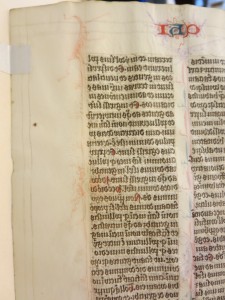 Multum in Parvo, and Little By Little
Multum in Parvo, and Little By Little
The new discoveries permit us to revisit the question of identifying the source manuscript within Ege’s collection. They bring to life, and give flesh to, more of its aspects.
As considered in my earlier blogpost, Scott Gwara suggested that the source manuscript for his Ege Handlist 61 is ‘Possibly Census 4′ (Gwara Handlist, number 61, page 140). That record is Seymour de Ricci, with the assistance of W.J. Wilson, Census of Medieval and Renaissance Manuscripts in the United States, Volume II (1937), page 1937, Item 4 in ‘The Library of Otto F. Ege, 188 South Compton Road, Cleveland, Ohio’.
The Census entry simply describes that manuscript thus:
4. Biblia. Vel[lum]. (c[irc]a 1375), 530 ff. [= folios] (19×13 cm.). Isaiah to Apocalypse only.
Written in France. 45 illum[inated]. initials; illum[inated]. borders. XVIIth c. brown calf.
Obtained (1932) from E. Dawson, Los Angeles.
Dawson, again.
A total of 530 folios, no matter how small in their size, even if only accounting for about half (say) of a full Bible, offers a very large number for distribution, given the inclination for a piecemeal approach. A plenitude of 45 illuminated initials and borders offers a desirable catch, with bounty for the taking, and with profit to booty (not a typo, that). This bounty could mount up, even if, as it could be (we don’t yet know), some of those 45 illuminated goodies stood on the same page or leaf as another, so that 1 sale would have been able to gobble more than 1 of those choice tidbits.
Whether or not Ege’s Pocket Bible of “1310 A.D.” is the same thing as Census Item 4 (or anyway its part as represented from “Isaiah to Apocalypse”), the identification of the leaf now at the Graduate Theological Union changes some of my approach to the research for further leaves. So far, I have depended upon, or resorted to, searching for surviving leaves through a focus mainly upon locating the individual sets of the Portfolios of Famous Bibles, and having to face the possibility that some of them, when laboriously found, might not contain a leaf from this manuscript. (AKA A Waste of Time?)
Given the discovery of the Zacharias leaf with its Illuminated Initial-and-Border, however, and with its associated clipping from the 1944 Lima Catalogue, I observe that another tactic is indicated, or, rather, also indicated. How to track and to trace other leaves which came up for sale or distribution apart from the Portfolios — presumably on account of their perceived increased value, which did not need to be squandered in a Portfolio? I invite suggestions and recommendations.
Looking for the Opening Pages of Individual Books of the Bible. Do you know of any from this little book? Looking for other pages, too, to be sure. Help Wanted.
The Dawson Connection Looms Larger
Other manuscripts which Otto Ege obtained from this same named source in Los Angeles are described, for example, in the same volume of the Census (1937), numbers 20 and 65 (pages 1940 and 1947).
- Census Number 20, an unbound Missal of ‘c[irc]a 80’ leaves ‘obtained (1932)’ likewise from ‘E. Dawson’, comprised part of a volume of which the other ‘half’ was then owned by Mr. Alfred Mewett, Cleveland’ (1895–1955), as described elsewhere in the Census.
= ‘Ege Manuscript 111’. Gwara Handlist 111 (page 155 and fig. 16)
Ege’s dismembered portion of a Missal from “England 1410” (according to Ege) in double columns of 39 lines. - Census Number 65, a Terence manuscript consisting of 103 leaves and still bound in ‘original wood boards and brown leather’, was ‘obtained (1935) from E. Dawson, Los Angeles’.
= ‘Ege Manuscript 78’. Gwara Handlist 78 (pages 145–146), described and partly illustrated, for example, here.
Comprising a Latin humanist copy of Terence’s Comedies written in Florence, Italy, circa 1475 by the accomplished scribe Guiliano d’Antonio da Prato, this latter manuscript was sold at Sotheby’s on 28 May 1934 as Lot 100. It was bought by Marks of Marks & Co, 84 Charing Cross Road, London. In a fairly short turn-around, the manuscript reached Ege’s collection via Dawson, in time to be recorded in the 1937 Census. Its travels and the identification of the scribe find a guide in
- A. C. de la Mare, ‘A Livy copied by Giacomo Curlo dismembered by Otto Ege’, in Interpreting and Collecting Fragments of Medieval Books, edited by Linda L. Brownrigg and Margaret M. Smith (2000), pages 57–88.
Specimens are viewable via http://www.columbia.edu/cu/libraries/inside/working/ds/qatool/html/CUL-273.html
That source in Los Angeles would be Earnest Dawson, bookseller (died 1947), founder of Dawson’s Book Shop. For that establishment there are available some Finding Aids for its records: Dawson’s Book Shop (1910–). Readers of our blogposts might remember that source as a distributor for dismembered manuscript fragments from our post and Booklet reporting, in another connection (so we thought), some fragments of
- New Testament Leaves in Old Armenian, from a manuscript distributed, at least in part, by Dawson’s Bookshop.
The Dawson connection as a source and distributor for Ege’s manuscripts and their dismembered portions calls for further exploration.
So far, the New York bookdealer Philip Duschnes (1897–1970) has been regarded as Ege’s principal conspirator in obtaining, dismembering, and distribution books. The extent of the association and the degree of the responsibility have been debated, partly as more of the evidence emerges. It becomes obvious to wonder to what extent Ernest Dawson participated in or precipitated the destructive activities.
Dawson as Agent and, Perhaps, Perpetrator
Whether or not Ege Manuscript 61 — a Vulgate Pocket Bible of “circa 1310 A.D.” for which, so far, leaves only from I Chronicles onwards in the Biblical order have have come to light — comprised the part-Bible of Census Number 4 obtained from E. Dawson, it is now important to take note of the distribution of at least 1 set of Ege’s Portfolio of Famous Bibles through Dawson’s Bookshop. This distribution is attested in the carbon-copy receipt for that set, fortunately still kept in the manila folder of “Extras” which apparently accompanied the shipment.
Dated 24 April 1937, that receipt recording the sale of 1 of Ege’s “Set of Bible Leaves” to Dr. E. Krupenhaas of Chestnut Hill, Philadelphia, Pennsylvania, for $50.00 (declared as tax-exempt because sent out-of-state).
If, as may be, Census number 4 in the ‘Library of Otto F. Ege’ by the time of the preparation of the Census description(s) was in fact this book, there deserve some answers. The preparation of the Census records for Ege’s Library manifestly occurred in stages, with a selection by Seymour de Ricci supplemented by ‘more ample notes’ by W. J. Wilson, as stated on page 1937. If this very Census item was the 32-line Pocket Bible which constitutes Ege Manuscript 61 in the Gwara Handlist and its pieces distributed in the 2 Portfolios Number 4, then the date of ‘circa 1375’ reported in the Census would have changed along the way to ‘1310’ by, and perhaps for, the distribution of leaves into the Famous Bible Portfolios (Series I & II), starting by 1936. Interesting.
The number of 530 folios in the Census accounts only for the Books of the Bible from Isaiah to the end of the New Testament. A small, but fat book. Perhaps this one?
The span as reported in the Census would include the Exekiel portion of the ‘New Leaf’. But — even considering variants for the order of the Books of the Bible in Pocket Bibles from Paris and other centers of production — it would presumably exclude the leaf from I Chronicles at Oberlin College, and perhaps also some other known leaves from the same Ege Handlist Manuscript 61 elsewhere, which I have not yet had a chance to inspect.
They may have strayed from another part, say volume I, of the same voluminous but pocket-sized Bible. They could mean a disturbed, or non-canonical, order of the Old Testament Books in Ege’s Census Manuscript 4. Or they point to a different manuscript instead.
If so, they disturbingly add to the count of manuscripts and leaves dismembered through Ege’s efforts to promulgate information, by the example of original specimens, and to obtain some financial remuneration, and perhaps academic kudos, along the way.
A Handful, And Then Some
If the sequence of the Biblical Books in Ege Manuscript 61 corresponds with the generally (not universally) established order of those Books for French Pocket Bibles, then the brief sampling which I have been able to discern of leaves distributed from the manuscript (both between the two Series of Portfolios and outside them) could establish that Ege (and/or others) despoiled a full copy of the Bible, with both Old and New Testaments, not just a large (albeit ‘small’, ha ha) part of it. If so, that Bible could have been divided into 2 volumes, say between Psalms and Isaiah, at a convenient half-way point given the bulk of the texts. Such division points are well attested in medieval copies of the Vulgate Latin Bible, in various formats. It’s a big text, even when little. (Yes, I mean that.)
Such divisions are not unknown in the history of the transmission of the Bible in full, in various formats, both little and large, and in between. (An early case, in awesome large-format, appears in an earlier post on The ‘Foundling Hospital’ for Manuscript Fragments.) In that case, the dismembered leaves would have come from both volumes, but that’s another story.
The Census record for Ege Library Item 4, if it in fact represented a volume of this manuscrtipt, could have caught a glimpse of the original — whether by chance, serendipity, or owner’s hubris, if not all these factors at once — at a moment in between the commencement of its dispersal and the progression to the rest. A valuable record, poignant to boot.
And so, if so, Ege might have obtained both volumes from his Los Angeles source; he might have obtained a single, whole manuscript containing both Testaments; and/or he and his biblioclastic associates might have begun despoiling the manuscript, say starting from the front, already before the Census description was prepared. Further research might decide the dismal case.
*****
On this optimistic note, we turn next to report discoveries for some other Ege Manuscripts. They include revelations among materials in the Otto Ege Collection at the Beinecke Rare Book and Manuscript Library at Yale University. So far, while we were exploring evidence for those other manuscripts — notably including Ege Manuscripts 8, 14, 41, and 51 — the evidence there for the Portfolios other than the Fifty Original Leaves (to which belong specimens from those first three listed manuscripts) and for Ege Manuscript 61 will have to await discovery.
P.S. If you know of other leaves from this little book, or other works by the same center (identity as yet unknown), please let us know!
We would be glad to hear from you. You could leave a comment, Contact Us, or join the conversation on our Facebook page. Over to you.
*****
Thanks Gladly
Gladly we thank the staff of the libraries of the Kent State University, The Morgan Library & Museum, the Houghton Library of Harvard University, and Firestone Library of Princeton University for help with inquires about materials in their collections. We also happily thank the staff of the Kislak Center for Special Collections, Rare Books, and Manuscripts of the University of Pennsylvania Libraries, and the Schoenberg Institute for Manuscript Studies at the University of Pennsylvania
Special thanks are recorded to
- Amanda Faehnel (Kent State University)
- Don Skemer and Brianna R. Cregle (Princeton University).
- John Pollock, Library Specialist, Kislak Center for Special Collections, Rare Books, and Manuscripts of the University of Pennsylvania Libraries
- Dot Porter and Lynn Ransom of the Schoenberg Institute for Manuscript Studies at the University of Pennsylvania
- David J. Stiver, Special Collections Librarian, Flora Lamson Hewlett Library, Graduate Theological Union, Berkeley, CA
The research can be complicated, not only when the materials are so widely dispersed without appropriate descriptions at the points of dispersal. Collaborative help is invaluable, and appreciated!
*****
Watch this space for further developments! See also the Contents List for this blog.
*****
Update:
P. S. Peter Kidd reported his consultation about the book:
“In February last year [2018], I emailed François Avril, attaching images of the small Bible, Ege 61:
The attached images show Bible leaves that have often been attributed to southern France. Apart from the purple penwork, they do not seem especially southern to me. Do they seem southern to you?
He replied:
For me these leaves are clearly parisian ca. 1330 or even a bit later. So is the penwork decoration of the second leaf. The use of violet instead of azure in the penwork does not exclude Paris, where this colour could be exceptionally employed.”
Excellent.
*****
Now see also:
More discoveries for manuscripts and other original materials appear on our blog. See the Contents List.
*****
Do you know of other leaves from this dispersed book? Do you recognize the hands of the scribes and artists in other works?
Please let us know. You might add your Comments here, Contact Us, and visit our Facebook Page.
Donations for our nonprofit mission are welcome. They are easy to make via Contributions and Donations.
*****

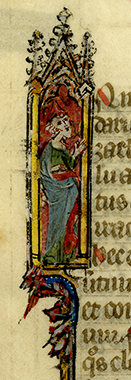
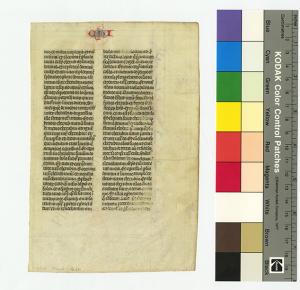
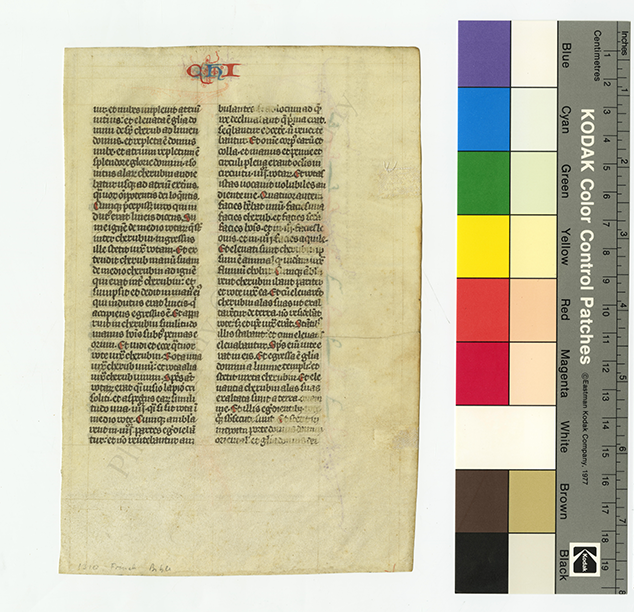
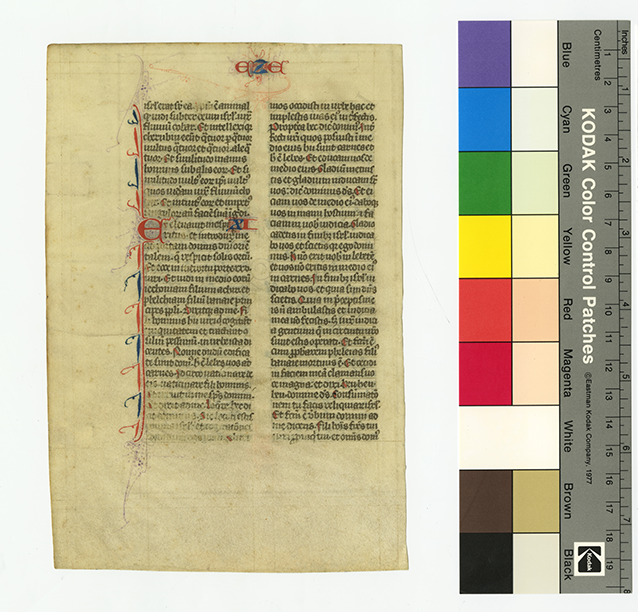
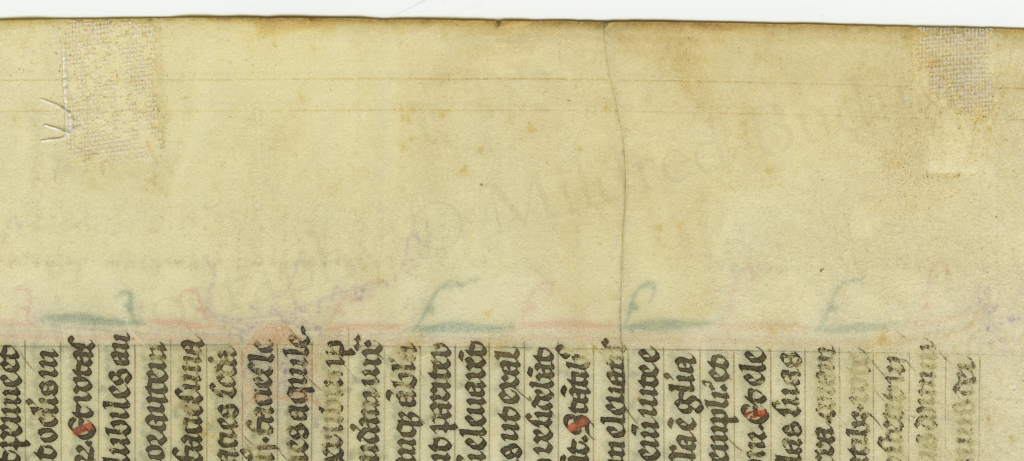

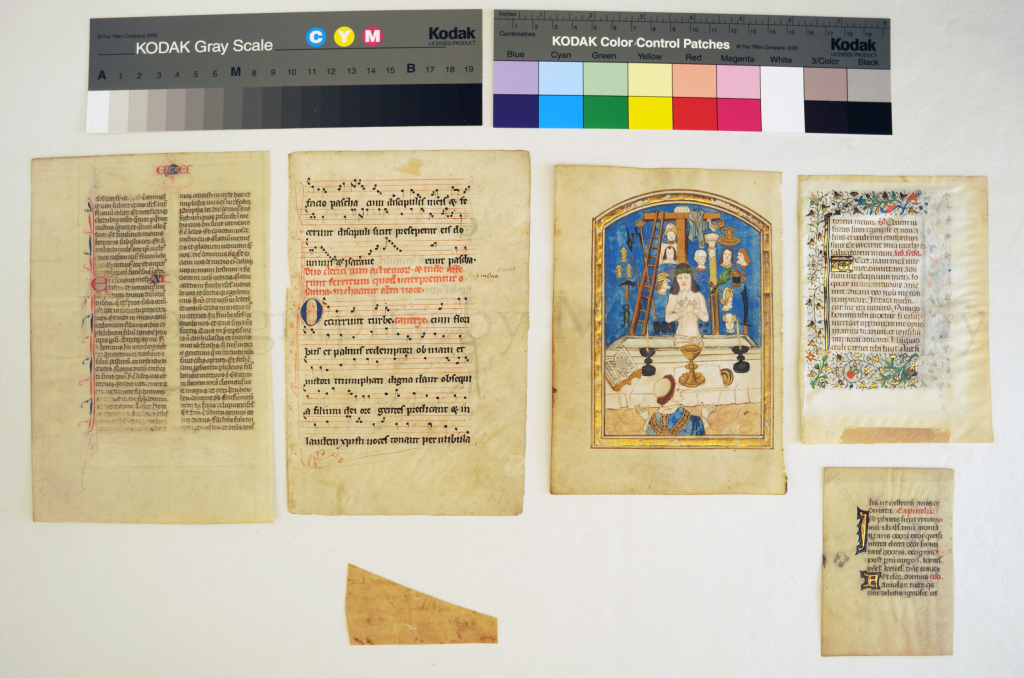
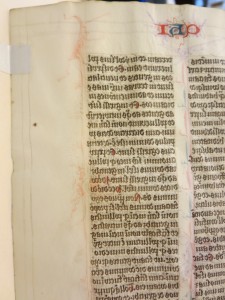
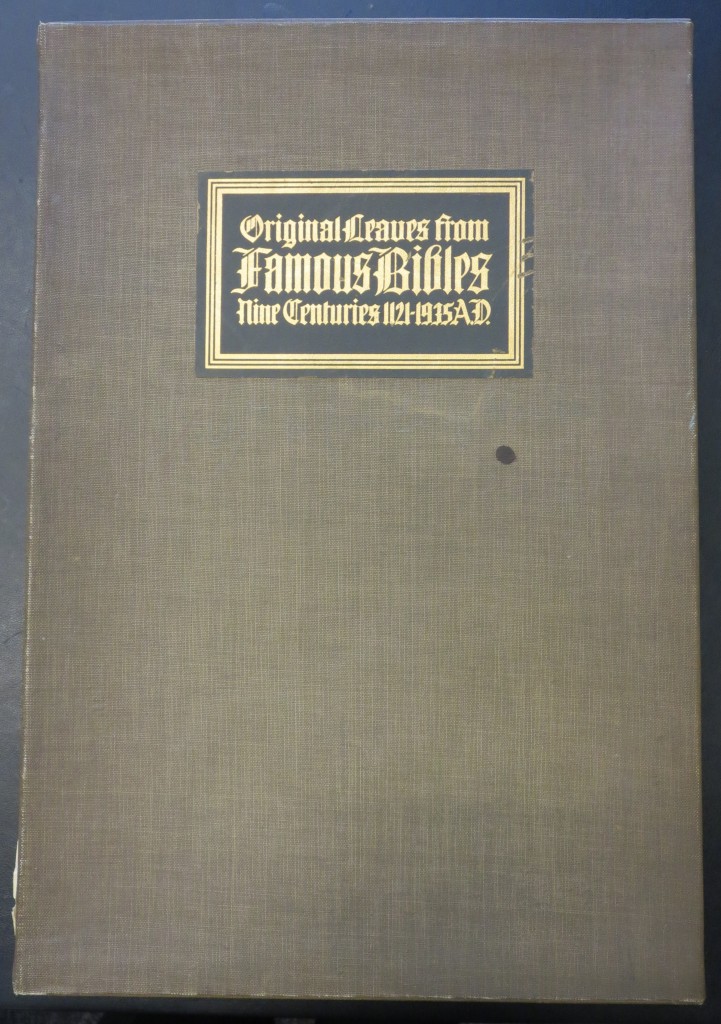
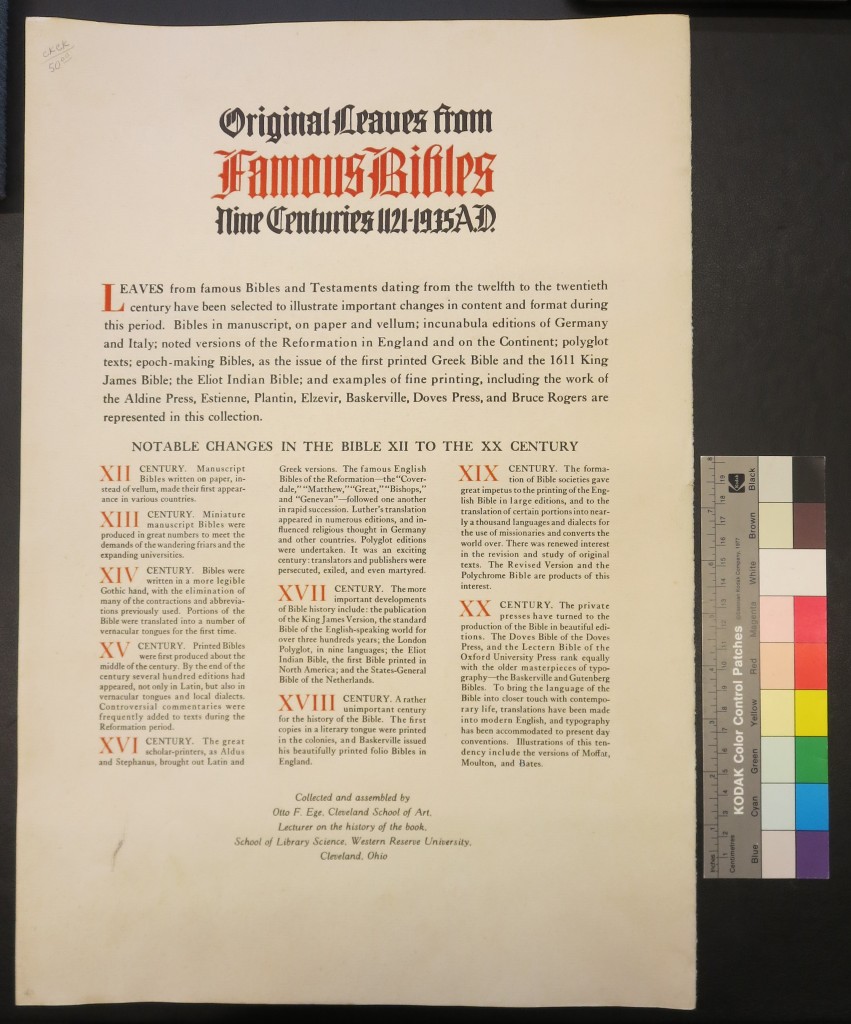
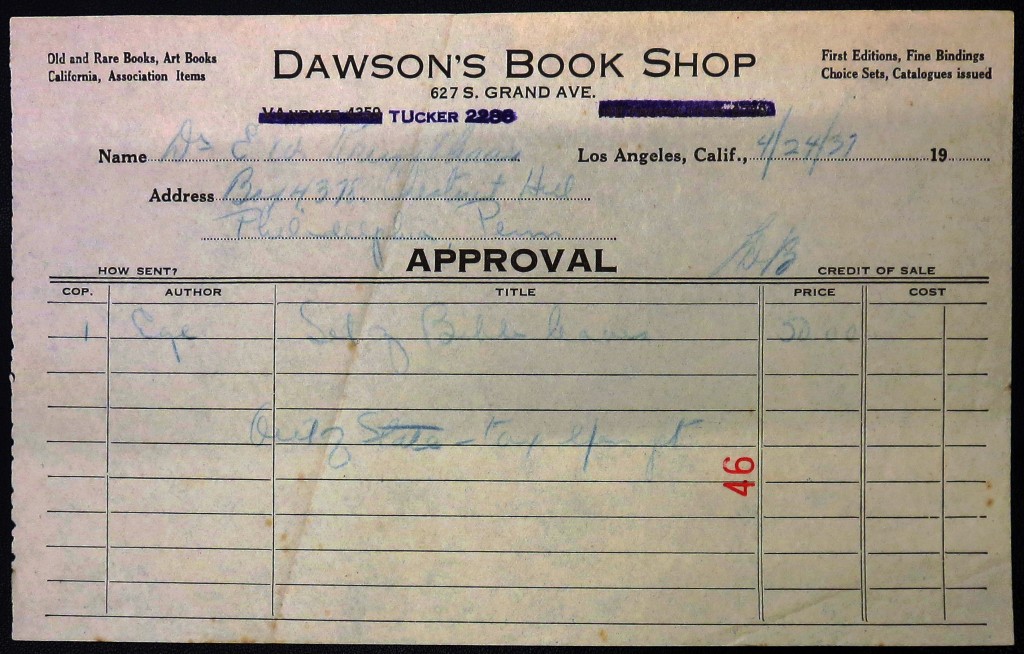


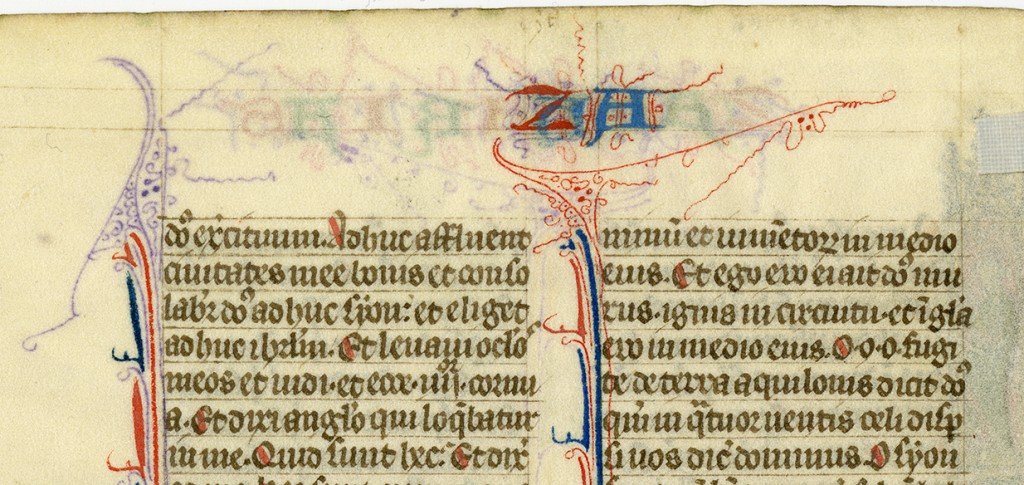
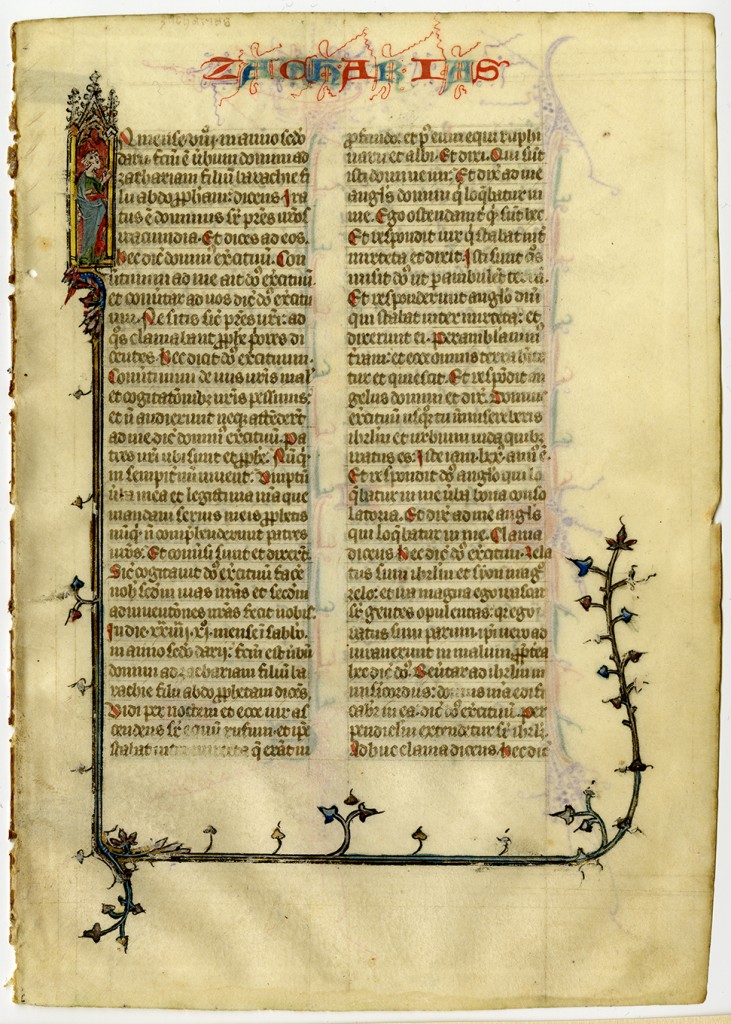
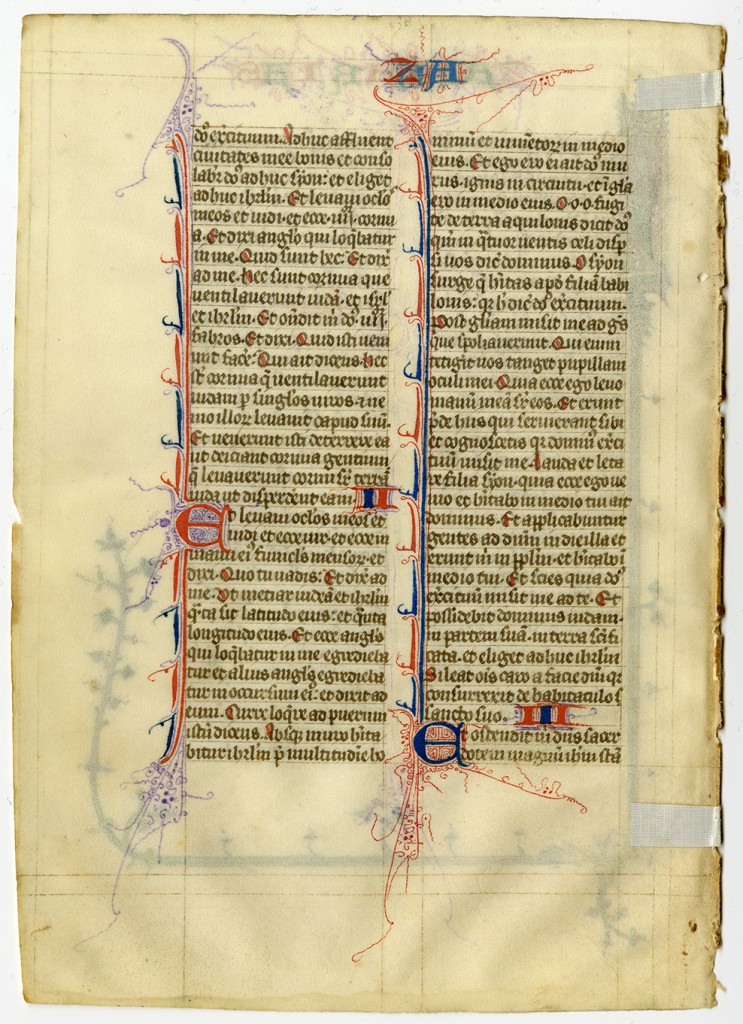
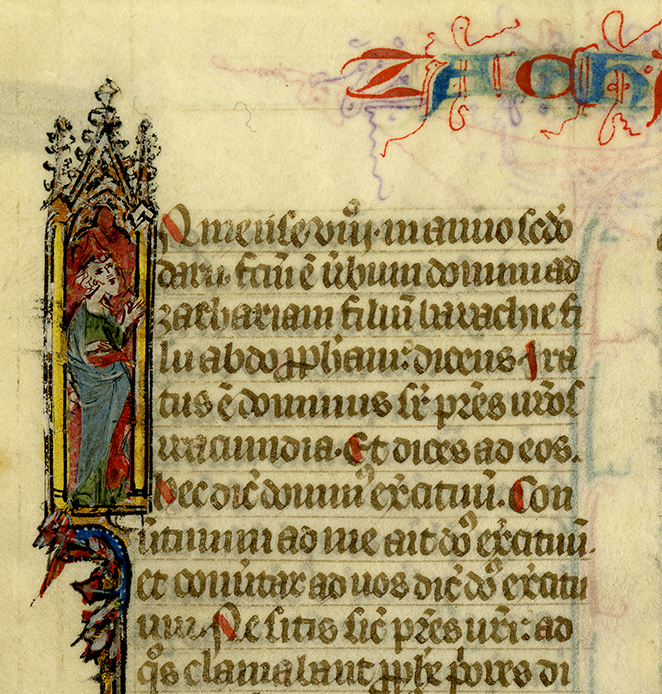
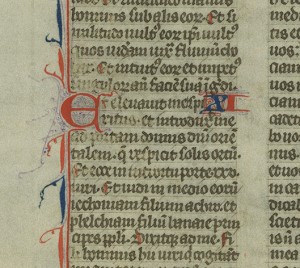
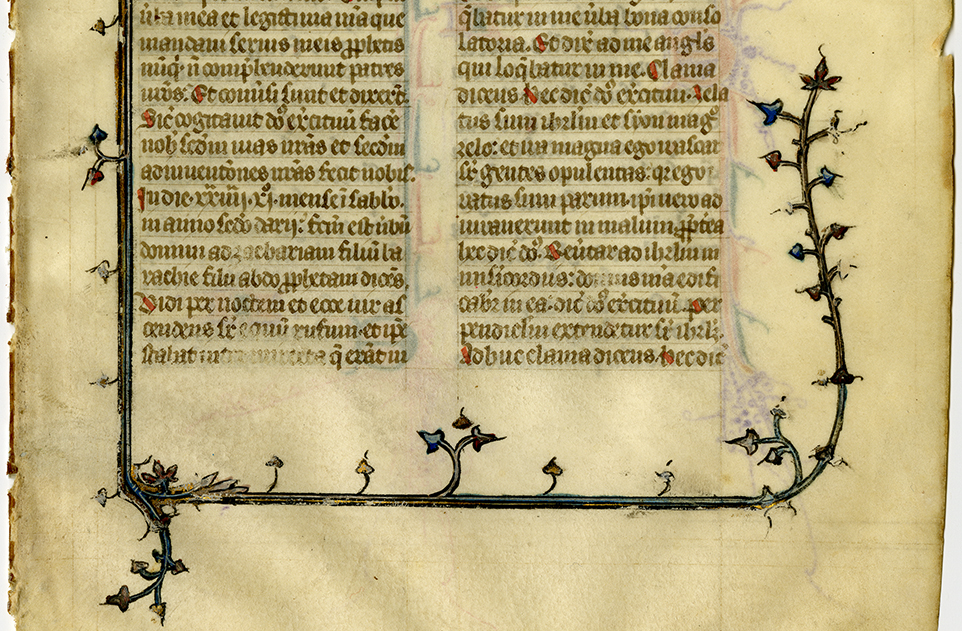
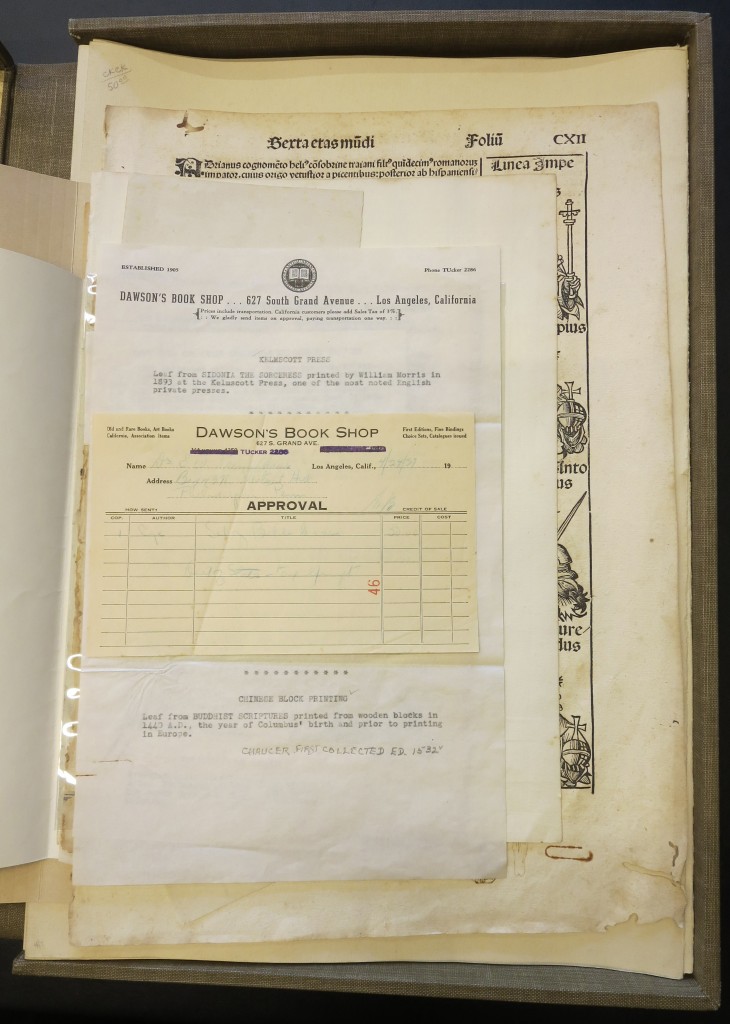
[…] Ege HL 61: Mildred Budny’s work on this tiny thirteenth-century Bible can be found here. […]